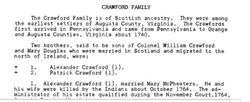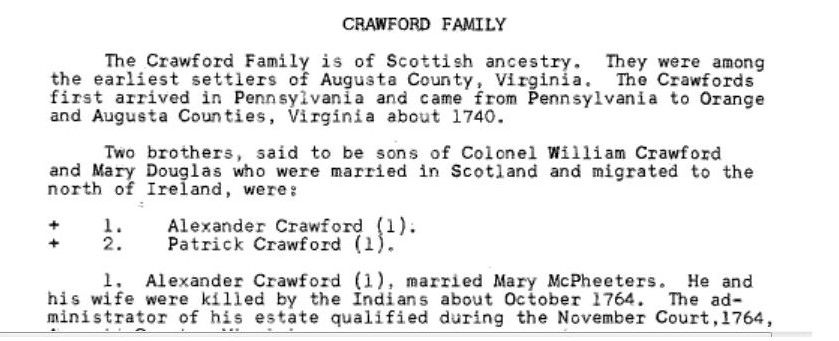His wife's maiden name was Mary McPheeters. He acquired an extensive tract of land in Augusta, covering a part of the Little North mountain, and extending far out into the plain. It embraced sixteen hundred and forty acres. His dwelling stood on a knoll, at the eastern base of the mountain, and looked out towards the rising sun on a wide tract of level land. It was "beautiful for situation." The spot is about two miles northeast of Buffalo Gap, and a hundred yards south of the present residence of Baxter Crawford, a great-grand-son of Alexander and Mary. The site of the house is now marked by a thicket, surrounding a pile of unhewn stones which composed the chimney
Here Alexander and Mary Crawford had eleven children, seven sons and fonr daughters. They had an abundance of all the good things the times and country afforded, and until the Indian wars arose, lived in peace and plenty. They belonged to a God-fearing race, and doubtless walked in the old ways of their pious ancestors. The father and mother, were, however, both slaughtered by savages, on their premises, with no human eye near enough to witness the tragedy.
Much uncertainty has existed as to the date of the occurrence. But at November County Court, 1764, William McPheeters qualified as administrator of Alexander Crawford, and, although some of the latter's descendants insist upon an earlier date, it seems highly probable, if not absolutely certain, that the slaughter was perpetrated in October of the year mentioned.
The rumor had gone abroad that an invasion by Indians was threatened, and all the Crawford family had taken refuge in a house at the Big Spring. This house was called a fort, being better able to resist an attack than most dwellings of the period, and was often resorted to by the people around in time of danger. It is probably the ancient stone house, still standing and used as a dwelling, on the south side of Middle river, two miles south of the present village of Churchville, and about three miles from Alexander Crawford's. It has long been known as the "old Keller house." The windows are few in number and very narrow, hardly more than a foot wide.
On the day of the slaughter, early in the morning, it is said, Alexander Crawford and his wife returned home to procure a supply of vegetables, while two of their sons, William and John, went upon the mountain to salt the horses which had been turned out to graze. From their elevation on the side of the mountain, the two youths saw the smoke and flames of the burning homestead.
We may imagine that the men of the neighborhood were somewhat slow to assemble. No one knew but his house would be attacked next, and every man felt it necessary to protect his own family if possible. When the people rallied and repaired to the Crawford place, the dwelling had been consumed by fire. The charred remains of Alexander Crawford were found in the ashes, showing that he had been killed in the house. His wife's body was found outside, and it was inferred that she had attempted to escape, but was overtaken and tomahawked. The remains of both were gathered up and buried in the Glebe graveyard.
The sale bill of Alexander Crawford's personal estate amounted to 333 British P. about $1,114, a larger sum than was common at that day. We mention as some indication of the state of the times. that among the articles sold by the administrator were a still and a wolf trap. All the family records and other household effects perished with the dwelling.
According to Genealogies of Kentucky Families from The Register of the Kentucky Historical Society, Vol. I Record for Genealogies of Kentucky Families from The Register of the Kentucky Historical Society, Vol. I:
His wife's maiden name was Mary McPheeters. He acquired an extensive tract of land in Augusta, covering a part of the Little North mountain, and extending far out into the plain. It embraced sixteen hundred and forty acres. His dwelling stood on a knoll, at the eastern base of the mountain, and looked out towards the rising sun on a wide tract of level land. It was "beautiful for situation." The spot is about two miles northeast of Buffalo Gap, and a hundred yards south of the present residence of Baxter Crawford, a great-grand-son of Alexander and Mary. The site of the house is now marked by a thicket, surrounding a pile of unhewn stones which composed the chimney
Here Alexander and Mary Crawford had eleven children, seven sons and fonr daughters. They had an abundance of all the good things the times and country afforded, and until the Indian wars arose, lived in peace and plenty. They belonged to a God-fearing race, and doubtless walked in the old ways of their pious ancestors. The father and mother, were, however, both slaughtered by savages, on their premises, with no human eye near enough to witness the tragedy.
Much uncertainty has existed as to the date of the occurrence. But at November County Court, 1764, William McPheeters qualified as administrator of Alexander Crawford, and, although some of the latter's descendants insist upon an earlier date, it seems highly probable, if not absolutely certain, that the slaughter was perpetrated in October of the year mentioned.
The rumor had gone abroad that an invasion by Indians was threatened, and all the Crawford family had taken refuge in a house at the Big Spring. This house was called a fort, being better able to resist an attack than most dwellings of the period, and was often resorted to by the people around in time of danger. It is probably the ancient stone house, still standing and used as a dwelling, on the south side of Middle river, two miles south of the present village of Churchville, and about three miles from Alexander Crawford's. It has long been known as the "old Keller house." The windows are few in number and very narrow, hardly more than a foot wide.
On the day of the slaughter, early in the morning, it is said, Alexander Crawford and his wife returned home to procure a supply of vegetables, while two of their sons, William and John, went upon the mountain to salt the horses which had been turned out to graze. From their elevation on the side of the mountain, the two youths saw the smoke and flames of the burning homestead.
We may imagine that the men of the neighborhood were somewhat slow to assemble. No one knew but his house would be attacked next, and every man felt it necessary to protect his own family if possible. When the people rallied and repaired to the Crawford place, the dwelling had been consumed by fire. The charred remains of Alexander Crawford were found in the ashes, showing that he had been killed in the house. His wife's body was found outside, and it was inferred that she had attempted to escape, but was overtaken and tomahawked. The remains of both were gathered up and buried in the Glebe graveyard.
The sale bill of Alexander Crawford's personal estate amounted to 333 British P. about $1,114, a larger sum than was common at that day. We mention as some indication of the state of the times. that among the articles sold by the administrator were a still and a wolf trap. All the family records and other household effects perished with the dwelling.
According to Genealogies of Kentucky Families from The Register of the Kentucky Historical Society, Vol. I Record for Genealogies of Kentucky Families from The Register of the Kentucky Historical Society, Vol. I:
Family Members
Advertisement
Records on Ancestry
Sponsored by Ancestry
Advertisement














